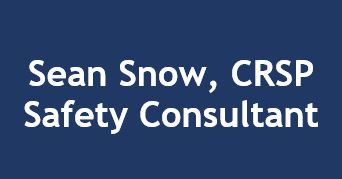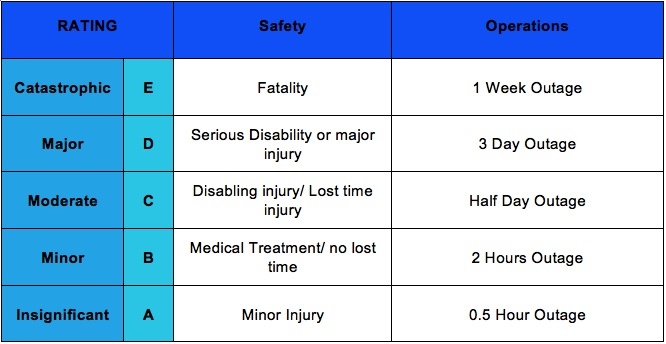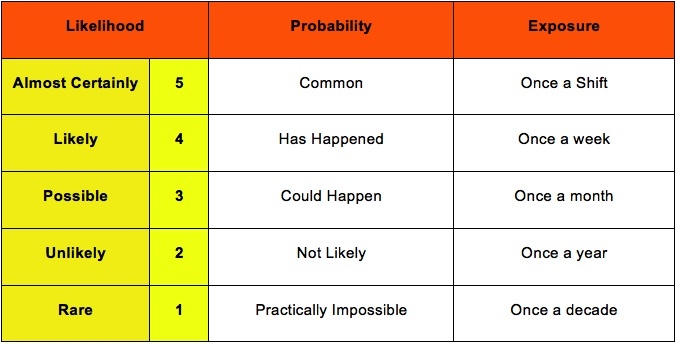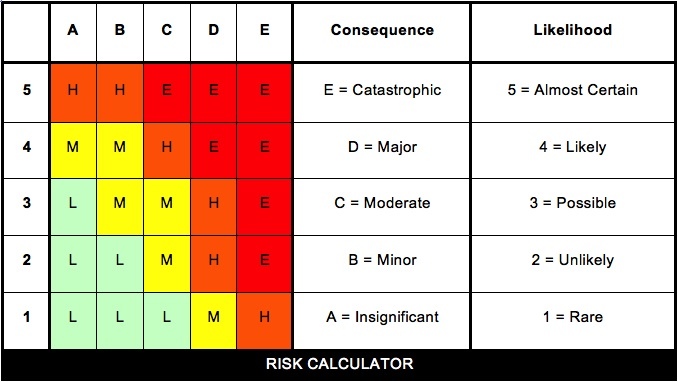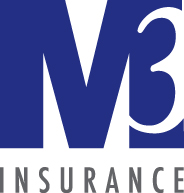Information
-
Assessment No.
-
Client Name
-
Client Contact
-
Conducted on
-
Prepared by
-
Location
-
Personnel
SECTION 1 - Risk Assessment
SECTION 1 - Confined Space Details
-
"confined space", except as otherwise determined by the Board, means an area, other than an underground working, that
(a) is enclosed or partially enclosed,
(b) is not designed or intended for continuous human occupancy,
(c) has limited or restricted means for entry or exit that may complicate the provision of first aid, evacuation, rescue or other emergency response service, and
(d) is large enough and so configured that a worker could enter to perform assigned work; -
What is the type of tank or opening that is being inspected?
- silos
- vats
- hoppers
- utility vaults
- tanks
- water supply towers
- sewers
- pipes
- access shafts
- truck or rail tank cars
- aircraft wings
- boilers
- manholes
- pump stations
- digesters
- manure pits and storage bins
-
Name/Type of Space
-
Location of Space
-
Atmospheric Hazard, pre hazard assessment
-
Confined Space to be Entered
-
Description of Confined Space
-
What are the usual products or materials contained within this confine space?
-
Authorized Entry Points
SECTION 2: SPACE DETERMINATION
-
Enclosed or partially closed?
-
The space is NOT designed or intended for continuous human occupancy?
-
Does the space have limited or restricted means for entry or exit that may complicate the provision of first aid, rescue or other response service?
-
Is the space large enough and so configured that a worker could enter to perform assigned work?
-
Space is a confined space per WorkSafeBC Part 9.1
-
Confined Space Category
-
Low hazard atmosphere If a worker enters a confined space which contains a low hazard atmosphere (a) another worker must be assigned as a standby person, (b) there must be a continuous means of summoning the standby person, (c) the standby person must check on the well-being of workers inside the space at least every 20 minutes, and (d) the standby person must have a means to immediately summon rescue personnel.
-
Moderate hazard atmosphere If a worker enters a confined space which contains a moderate hazard atmosphere (a) another worker or workers must be assigned as the standby person(s), (b) a standby person must be stationed at or near the entrance to the space, (c) the standby person must visually observe or otherwise check the well-being of the worker(s) inside the space, as often as may be required by the nature of the work to be performed, but at least every 20 minutes, (d) there must be a continuous means of summoning the standby person from inside the space, and (e) the standby person must have a means to immediately summon rescue personnel.
-
High hazard atmosphere, engulfment or entrapment If a worker enters a confined space which contains a high hazard atmosphere, a risk of engulfment or entrapment or with any other recognized serious health or safety hazard (a) another worker or workers must be assigned as the standby person(s), (b) the standby person(s) must be stationed at the entrance to the space and must continuously attend to the standby duties, (c) the standby person(s) must visually observe or otherwise continuously monitor the well-being of the worker(s) inside the space, (d) there must be a continuous means of summoning the standby person(s) from inside the space, (e) the standby person(s) must be equipped and capable of immediately effecting rescue using lifting equipment if required, or otherwise performing the duties of rescue persons, and (f) the standby person(s) must prevent the entanglement of lifelines and other equipment.
SECTION 3: SPACE CHARACTERISTICS - Description of Space
-
Space ID No.:
-
No. of Entry Points:
-
Height:
-
Width:
-
Length:
-
Diameter:
-
Volume:
-
General Shape:
-
Use/Function:
-
Internal Machinery:
-
Adjacent Piping:
-
Electrical:
-
Internal Spaces Within:
-
Notes:
-
Step 1 - Consider Concequences
What are the consequences of this hazard occurring? Consider what is the most probable consequence (below) with respect to this work hazard -
-
Step 2 - Consider Likelihood
What is the likelihood (below) of the hazard consequence in Step 1 occurring? -
-
Step 3 - Calculate Risk
1. Take Step 1 Rating and select the correct column
2. Take Step 2 Rating and select the correct row
3. Use the risk score where the two ratings cross on the below matrix
E = Extreme
H = High
M = Moderate
L = Low -
-
Description of Entry/Egress Points
SECTION 4: PRE-EXISTING CONDITIONS - Atmospheric Hazards
-
Oxygen Deficiency (<19.5%)
-
Risk Level
-
Oxygen Enrichment (>23.0%)
-
Risk Level
-
Fire/Explosive Gases/Vapours
-
Risk Level
-
Hydrogen Sulfide
-
Source
-
Risk Level
-
Carbon Monoxide
-
Risk Level
-
Ammonia
-
Source
-
Risk Level
-
Chlorine
-
Source
-
Risk Level
-
Organic Vapours
-
Source
-
Risk Level
-
undefined
Chemical Hazards
-
Controlled Products
-
Source, Description (SDS)
-
Risk Level
-
Ingestion/Skin Contact
-
Source
-
Risk Level
-
Chemical Reactivity
-
Source
-
Risk Level
-
Chemical Residue/Sludge
-
Source
-
Risk Level
Biological Hazard
-
Mould/Bacteria
-
Source
-
Risk Level
-
Sewage (Human Organic Matter)
-
Source
-
Risk Level
-
Animal Organic Matter
-
Source
-
Risk Level
Physical Agents
-
Noise/Vibration
-
Heat/Cold Stress
-
Non-Ionizing Radiation
-
Source
-
Laser
-
Source
Physical Configuration
-
Structural
-
Personal Confinement
-
Floor Openings/Double Bottom
-
Convoluted Space
Physical Hazards
-
Overhead
-
Sharp Edges
-
Mechanical
-
Lockout Required?
-
Electrical
-
Lockout Required?
-
Hydraulic
-
Lockout Required?
-
Pneumatic
-
Lockout Required?
-
Adjacent Piping/Process Lines
-
Lockout Required?
-
Blanking, Blinding Required?
-
Liquid/Water Accumulation
-
Source
-
Flooding
-
Engulfment/Bridged Materials
-
Source
-
Entrapment/Entanglement
-
Source
-
Fall
-
Entry/Exit
-
Hot/Cold Working Surfaces
-
Sharps (Needles/Syringes)
-
Vehicle Traffic/Moving Eqpt
-
Worker/Public Interference
-
Animal Interaction
Safety Hazards
-
Visibility/Light Level
-
Communication
-
Ergonomic
-
Slip/Trip
-
Weather Conditions
SECTION 5: ENTRY REQUIREMENTS
-
Entry required into the space?
-
Describe the requirements for entry into this space.
SECTION 6: WORK ACTIVITIES
-
What work activities will be undertaken within this space.
SECTION 7: ADDITIONAL HAZARDS BASED ON SPECIFIC WORK ACTIVITIES
-
Equipment misuse
-
Describe Any additional hazards based on work activities.
-
Risk Level
SECTION 8: SPACE HAZARD CLASSIFICATION BASED ON WORK ACTIVITIES
-
Atmospheric Hazard Class
-
Overall Risk Level
SECTION 9: SIGN-OFF & ACCEPTANCE
Assessor (Person who wrote this assessment)
-
Name
-
Title
-
Signature
-
Date
Additional Reviewer
-
Name
-
Title
-
Signature
-
Date
Accepted By Superintendent
-
Name
-
Title
-
Signature
-
Date
PART 2 - Entry Permit
SECTION 2 - Entry Permit
-
Isolation Controls
Does this Confined Space need to be isolated from the hazard conditions below? -
Water / Gas / Steam / Chemicals
-
Mechanical / Electrical Drives
-
Hydraulic / Electric / Gas / Power
-
Sludge / Deposits / Waste
-
Auto Fire Extinguishing Systems
-
Locks &/or Tags will be Affixed to Isolation Points
-
Other
-
Purging, Ventilation & Atmospheric Monitoring Controls
Does this Confined Space require the following? -
Depressurising
-
Opening / Venting
-
Continuous Purging / Extraction
-
Atmospheric Testing Required for
-
Oxygen (O2)
-
Carbon Monoxide (CO)
-
Hydrogen Sulphide (H2S)
-
Carbon Dioxide (CO2)
-
LEL
-
Ammonia (NH3)
-
Volatile Organic Compounds (VOC)
-
Other
-
Type of Testing / Monitoring Required
-
Initial Only - Prior to entry and each subsequent day
-
Continuous for Atmospheric Contaminants
-
Continuous for Flammable Contaminants
-
Communication & Stand By Controls
Minimum Requirements will include -
One Stand By Person
-
Two or More Stand By Persons
-
Rescue Team
-
Communication Via Voice and Direct Sight
-
Communication Via Radio
-
Communication Via Hand Signals and Other Means
-
Rescue / Retrieval Considerations
Minimum Provisions are to include -
Stand By Person to individually handle
-
Safety Harness / Rescue Kit in vicinity with competent user(s)
-
Specific access to platforms/scaffolding erected
-
Specific Fire fighting provisions
-
First aid kit in vicinity
-
Other
-
Personal Protective Equipment (PPE) Requirements
Minimum items required -
Supplied breathing apparatus
-
Air purifying respirator
-
Particulate mask (N95)
-
Safety harness and lanyard / lifeline
-
Head protection
-
Face shield / goggles / safety glasses
-
Hearing Protection.
-
Gloves
-
Warning notices / barricading
-
Specific lighting provisions
-
Specific hot work controls
-
Other
Permit Request
-
This acknowledgement signifies a formal request to commence confined space entry / works. As the person requesting this permit, I hereby certify that; 1. I am competent to coordinate this confined space entry / work in accordance with the previous Risk Assessment & Entry Permit details; 2. I shall undertake to implement all planned and necessary controls to ensure safe entry / work; 3. I shall monitor confined space hazards and control methods throughout the entry / work;
-
Time & Date Signed
Permit Authorization
-
This authorization signifies that the planning component of the Risk Assessment & Entry Permit has been completed and that the confined space entry / work is authorized to commence in accordance with the Permit Request.
-
Time & Date Signed
SECTION 3 - Implementation
SECTION 3 - Implementation
-
Atmospheric Test Results
-
Test Time & Date
-
NOT SAFE TO ENTER
Re-Test and confirm safe limits with supervisor -
NOT SAFE TO ENTER
Re-Test and confirm safe limits with supervisor -
NOT SAFE TO ENTER
Re-Test and confirm safe limits with supervisor -
NOT SAFE TO ENTER
Re-Test and confirm safe limits with supervisor -
NOT SAFE TO ENTER
Re-Test and confirm safe limits with supervisor -
NOT SAFE TO ENTER
Re-Test and confirm safe limits with supervisor -
NOT SAFE TO ENTER
Re-Test and confirm safe limits with supervisor -
Other
-
Gas Detector Number
-
Entry Permitted?
-
Personnel taking results
-
Another test
-
Atmospheric Test Results
-
Test Time & Date
-
NOT SAFE TO ENTER
Re-Test and confirm safe limits with supervisor -
NOT SAFE TO ENTER
Re-Test and confirm safe limits with supervisor -
NOT SAFE TO ENTER
Re-Test and confirm safe limits with supervisor -
NOT SAFE TO ENTER
Re-Test and confirm safe limits with supervisor -
NOT SAFE TO ENTER
Re-Test and confirm safe limits with supervisor -
NOT SAFE TO ENTER
Re-Test and confirm safe limits with supervisor -
NOT SAFE TO ENTER
Re-Test and confirm safe limits with supervisor -
Other
-
Gas Detector Number
-
Entry Permitted?
-
Personnel taking results
-
Another test
-
Atmospheric Test Results
-
Test Time & Date
-
NOT SAFE TO ENTER
Re-Test and confirm safe limits with supervisor -
NOT SAFE TO ENTER
Re-Test and confirm safe limits with supervisor -
NOT SAFE TO ENTER
Re-Test and confirm safe limits with supervisor -
NOT SAFE TO ENTER
Re-Test and confirm safe limits with supervisor -
NOT SAFE TO ENTER
Re-Test and confirm safe limits with supervisor -
NOT SAFE TO ENTER
Re-Test and confirm safe limits with supervisor -
NOT SAFE TO ENTER
Re-Test and confirm safe limits with supervisor -
Other
-
Gas Detector Number
-
Entry Permitted?
-
Personnel taking results
-
Another test
-
Atmospheric Test Results
-
Test Time & Date
-
NOT SAFE TO ENTER
Re-Test and confirm safe limits with supervisor -
NOT SAFE TO ENTER
Re-Test and confirm safe limits with supervisor -
NOT SAFE TO ENTER
Re-Test and confirm safe limits with supervisor -
NOT SAFE TO ENTER
Re-Test and confirm safe limits with supervisor -
NOT SAFE TO ENTER
Re-Test and confirm safe limits with supervisor -
NOT SAFE TO ENTER
Re-Test and confirm safe limits with supervisor -
NOT SAFE TO ENTER
Re-Test and confirm safe limits with supervisor -
Other
-
Gas Detector Number
-
Entry Permitted?
-
Personnel taking results
-
Another test
-
Atmospheric Test Results
-
Test Time & Date
-
NOT SAFE TO ENTER
Re-Test and confirm safe limits with supervisor -
NOT SAFE TO ENTER
Re-Test and confirm safe limits with supervisor -
NOT SAFE TO ENTER
Re-Test and confirm safe limits with supervisor -
NOT SAFE TO ENTER
Re-Test and confirm safe limits with supervisor -
NOT SAFE TO ENTER
Re-Test and confirm safe limits with supervisor -
NOT SAFE TO ENTER
Re-Test and confirm safe limits with supervisor -
NOT SAFE TO ENTER
Re-Test and confirm safe limits with supervisor -
Other
-
Gas Detector Number
-
Entry Permitted?
-
Personnel taking results
-
Another test
-
Atmospheric Test Results
-
Test Time & Date
-
NOT SAFE TO ENTER
Re-Test and confirm safe limits with supervisor -
NOT SAFE TO ENTER
Re-Test and confirm safe limits with supervisor -
NOT SAFE TO ENTER
Re-Test and confirm safe limits with supervisor -
NOT SAFE TO ENTER
Re-Test and confirm safe limits with supervisor -
NOT SAFE TO ENTER
Re-Test and confirm safe limits with supervisor -
NOT SAFE TO ENTER
Re-Test and confirm safe limits with supervisor -
NOT SAFE TO ENTER
Re-Test and confirm safe limits with supervisor -
Other
-
Gas Detector Number
-
Entry Permitted?
-
Personnel taking results
-
Another test
-
Atmospheric Test Results
-
Test Time & Date
-
NOT SAFE TO ENTER
Re-Test and confirm safe limits with supervisor -
NOT SAFE TO ENTER
Re-Test and confirm safe limits with supervisor -
NOT SAFE TO ENTER
Re-Test and confirm safe limits with supervisor -
NOT SAFE TO ENTER
Re-Test and confirm safe limits with supervisor -
NOT SAFE TO ENTER
Re-Test and confirm safe limits with supervisor -
NOT SAFE TO ENTER
Re-Test and confirm safe limits with supervisor -
NOT SAFE TO ENTER
Re-Test and confirm safe limits with supervisor -
Other
-
Gas Detector Number
-
Entry Permitted?
-
Personnel taking results
-
Another test
-
Atmospheric Test Results
-
Test Time & Date
-
NOT SAFE TO ENTER
Re-Test and confirm safe limits with supervisor -
NOT SAFE TO ENTER
Re-Test and confirm safe limits with supervisor -
NOT SAFE TO ENTER
Re-Test and confirm safe limits with supervisor -
NOT SAFE TO ENTER
Re-Test and confirm safe limits with supervisor -
NOT SAFE TO ENTER
Re-Test and confirm safe limits with supervisor -
NOT SAFE TO ENTER
Re-Test and confirm safe limits with supervisor -
NOT SAFE TO ENTER
Re-Test and confirm safe limits with supervisor -
Other
-
Gas Detector Number
-
Entry Permitted?
-
Personnel taking results
-
Another test
Entry Authorisation
-
The procedures, control measures and precautions appropriate for the safe entry / work in this confined space have been implemented and the persons required to work in the confined space have been David of and understand the requirements of the Risk Assessment & Entry Permit
-
Time & Date Signed
-
CONSTRAINTS This Entry Authorisation is valid until the following occurs or the time and date shown
-
Select date
Personnel Entry
-
I the undersigned, hereby acknowledge that I fully understand the procedure, control measures and precautions to be observed with the entry / work and exit involved with this confined space. I will comply with these requirements at all times and report any unforeseen hazard that presents a risk to safety
-
Add signature
-
Select date
-
Add signature
-
Select date
-
Add signature
-
Select date
-
Add signature
-
Select date
Withdrawal of Entry Authorisation
-
All persons and equipment has been accounted for and the equipment and confined space has been restored correctly and safely
-
Select date
